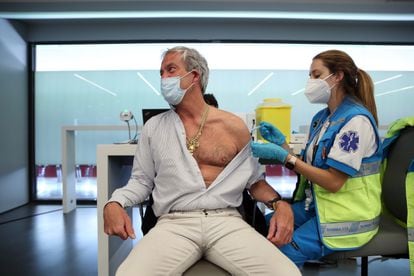Spain misses June vaccination target with nearly three million doses still in storage
A total of 14.4 million people now have full protection offered by the vaccines, 568,317 short of the target that the government had set for the previous week
/cloudfront-eu-central-1.images.arcpublishing.com/prisa/6CDZNQRFGNF4VPO3LG6HBMX4FU.jpg)

Spanish Health Minister Carolina Darias likes to say that the country’s Covid-19 vaccination drive “is right on target.” But it could be going faster. The regions, which are responsible for the immunization drive as well as controlling the pandemic in their territories, have a stock of 2.9 million doses waiting to be administered. Some of these shots have been kept back in reserve to ensure the vaccination drive can carry on without interruption in case there is a shipment delay or other setback. But there is no reason for the delay in administering the more than 2.1 million doses of the Oxford-AstraZeneca vaccine and one-shot Janssen medication, which will be used to fully vaccinate citizens.
Last week, the government missed its first vaccination target since Prime Minister Pedro Sánchez outlined the roadmap to immunize 70% of the population by the end of summer. The first two goals – to have 10 million people fully vaccinated by the first week of June and five million by the first week of May – were both met on schedule. The next objective, according to the plan announced in April, was to have 15 million people fully vaccinated by June 20. But according to the Health Ministry report released on Monday, this figure stands at 14.4 million. This goal would have been reached if the more than 2.1 million doses of Janssen and AstraZeneca in stock had been administered.
The secretary of state for health, Silvia Calzón, said on Monday that the “small delay” in the vaccination schedule was due to the setbacks with the arrival of the vaccine made by Janssen, which is a subsidiary of the US pharmaceutical giant Johnson & Johnson. Of the 5.5 million doses expected to be delivered in the second quarter, only 1.5 million have been sent so far due to a problem at Johnson & Johnson’s main factory. “There will be a delay of two to three days. We are convinced that we will recover to be able to exceed [the next vaccination target] of having 50% of the population fully vaccinated by July 25 and 70% by August 18,” said Calzón.
But the Janssen delay does not explain why there are nearly three million doses still in stock – a problem that has less to do with the US pharmaceutical firm and more to do with Spain’s vaccination strategy. According to its technical sheet, the second shot of the AstraZeneca vaccine required for full protection can be administered between three and 12 weeks after the first. But Spain recommends that the second dose be delivered after 10 or preferably 12 weeks, and has even extended the interval to 16 weeks for the under-60s.
Administering the second dose after these time periods has been seen to boost a person’s immune response, but means the vaccination campaign progresses more slowly. And this could be a problem given the threat of the delta strain of the coronavirus, first detected in India. Preliminary studies from the United Kingdom indicate that Covid-19 vaccines are just as effective against the delta strain as the alpha, which was first detected in England, when a person is fully vaccinated. But according to this research, Covid-19 vaccines are less effective against this strain when only one dose has been administered. This has prompted some regions such as Madrid, Catalonia and Andalusia to announce that they will be reducing the period between the two shots to 10 weeks.

The vaccination drive is advancing at different speeds across the regions. While Madrid maintains it is rushing to fully vaccinate residents, it has only administered 87% of all vaccines received – the lowest figure of all Spain’s 17 regions. On the opposite end of the spectrum are Asturias (98.7%) and Andalusia (96.8%), according to the Health Ministry report, which does not detail how many doses of each vaccine remain in stock in each region.
On average, Spain is administering more than 90% of all vaccines received. But this 10%, which represented just thousands of doses during the beginning of the campaign, is now equal to millions of shots.
Regional authorities questioned by EL PAÍS say vaccines are being held in reserve to ensure second doses can be administered without delays in case of unexpected setbacks. But this would only explain the fewer than 900,000 doses of the Pfizer-BioNTech and Moderna vaccine. The Janssen vaccine only requires one shot, meaning the medication could be administered as it arrived if healthcare systems were better prepared. Instead, more than half a million Janssen shots remain in storage.
There have also been problems with the delivery of the AstraZeneca vaccine as the pharmaceutical has not adhered to the agreed-to schedule or shipped the promised number of doses. This has made long-term planning difficult, but does not explain why Spain has 1.6 million shots of the medication and has yet to administer them.
The delay is having the biggest impact on the 60-69 population, most of whom received the AstraZeneca vaccine. Less than one-third of this age group is fully vaccinated, compared to 54% of the 50-59s, who began to be immunized at a later date.
Experts do not have a common response on how to best address the problem. Federico Martinón, a pediatrician and vaccination advisor at the World Health Organization (WHO), argues the interval between the AstraZeneca shots should be shortened to ensure the 60-69 age group has full coverage as soon as possible. “Fully vaccinating this age group takes priority over immunizing a person who is 40 years old,” he says, pointing out that this demographic is now the most vulnerable to Covid-19, given that nearly all of the over-70s are fully vaccinated. Fernando Rodríguez Artalejo, a professor of Public Health at Madrid’s Autonomous University, however, believes the delta variant should continue to be observed before changes are made, and that the 60-69 age group should be asked to take greater precautions while they wait for the second dose.
According to the latest Health Ministry report on coronavirus variants, the delta strain only accounts for 1% of new cases. But this document is based on data that is up to four weeks out of date. Regions such as Madrid and Catalonia warn that the delta strain will be predominant in a matter of weeks, a forecast backed by some experts.
Fernando Simón, the director of the Health Ministry’s Coordination Center for Health Alerts (CCAES), however, said on Monday that the delta variant is not spreading “very quickly” in Spain. Indeed, the incidence rate in the country continues to fall. According to Monday’s Health Ministry report, the 14-day cumulative number of cases per 100,000 inhabitants now stands at 92.46, a slight fall on Friday’s figure of 95.91. There are currently 2,832 Covid-19 patients in hospital and 770 in intensive care units (ICUs), with the occupancy rate at 2.30% and 8.23% respectively. A total of 37 deaths were recorded on Monday – which includes figures from Saturday and Sunday – bringing the official toll to 80,689. This figure is likely to be much higher given that thousands of people died without being diagnosed during the first wave, meaning they were not included in the official count.
With reporting by Juan Navarro, Cristina Vázquez, Guillermo Vega, Mikel Ormazabal, Margot Molina and Silvia R. Pontevedra.
English version by Melissa Kitson.
/cloudfront-eu-central-1.images.arcpublishing.com/prisa/XUVLBHOCYB4OTYU25ZZ5ZQTUUM.jpg)
/cloudfront-eu-central-1.images.arcpublishing.com/prisa/V73P6X72QUCVYLUXE7OBJ7K7VM.jpg)










































